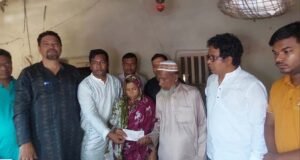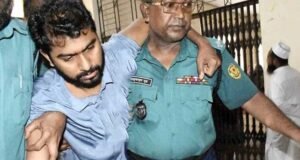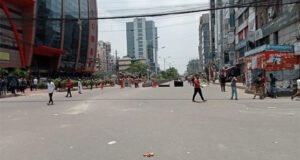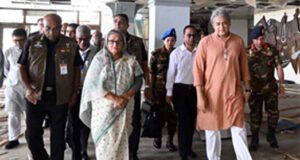
Dr. Anthonie Holslag:
Memories and trauma
The title of this article is really a misnomer and misleading. There is no such thing as “old” pain. There is relief of pain. And people stuck in a trauma can relive this suffering over and over again.
I had to think of this when I went on my fact-finding mission in May 2023 with former PM Harry van Bommel, security analyst Chris Blackburn, Ansar Ahmed Ullah, and Bikash Chowdhury Barua from the European Bangladesh Forum. The aim of this one-week mission was to collect as many eyewitness accounts, see memorial sites and see the killing fields of all the occurrences that happened in 1971 in Bangladesh. I was the scholar in the team. It was my job to determine if a genocide occurred and more importantly what the cultural trauma was that still marked the country. Now, this is not a job you can do in a week. It takes in depth research. For a cultural trauma is complicated. It consists of tales, imagery and symbolism. But I could at least encounter first impressions.

It was a hectic week. We went to universities and memorial sites, spoke with survivors, went to the genocide centre, and went on a TV show and press conferences, both in Dhaka and Chittagong. The first thing I noticed was how open and hospitable everyone was. I think I ate everything in Bengali cuisine and gained 10 pounds. The second thing I noticed was that everyone had a story to tell. Stories about what they had witnessed as children or about relatives that were missing or got murdered in the most horrendous ways. There were no words of comfort I could give. No way to lessen the suffering. And let me return here what I stated above: memories and traumas. Traumas get relieved.

These people didn’t remember what happened, but they relived it. I could see it in their body language, in the way they looked away as if they saw the killing fields instead of the present fields. I saw it in the anguish and pleads on their faces. I was the scholar. They wanted confirmation and closure, but considering the job I had to do, there was none I could give. It was impossible for me to take this amount of suffering, expressed in simple words, away. I could only register it, and whatever happened here was so enormous that people were, in a way, stuck in their past.
Mass killings and genocide
The question that I got posted the most was if the killings in 1971 were considered mass murder. The simple answer to this is yes. From a scholarly standpoint, however, the question is much more difficult to answer. Genocide includes mass murder but is, in essence, much more than that, not just from a social scientific point of view but also from a legal point of view. For example, Hiroshima and Nagasaki can be considered mass murders and fall under the war crime clause. Genocide, as Lemkin already claimed in his book of 1944. Which was ratified during the genocide convention of 1948. Genocide is the annihilation of a group of people based on their ethnical, racial, national or religious identity. Identity is the keyword here. Where during mass killings, thousands or more people get killed. The aim was not to kill all Japanese. And the aim of a war crime is essential. Genocide aims to destroy an identity in all its aspects. This is the reason why we see in genocide not just the physical act of killing but also the destruction of mosques and churches, the destruction of language, the destruction of cultural heritage, the killing of the elite and even the act of killing itself we see how identity markers are targeted. Violence in genocide is both ritualised and filled with symbolism. People are often dehumanised, also an identity indicator, to such an extent that they are killed as cattle.

The source of this horrendous act lies in the perpetrators. They consider the other, in this case, the Bengali, as an existential threat that has to be eliminated for the Pakistani identity to survive. And this is exactly what happened in 1971. When Eastern Pakistanis wanted to become independent, Pakistan saw this as a threat to the whole Pakistan nation. The fact that the Bengalis had their language and customs only deepened and fed this fear. Now, keep in mind that this is an imaginary threat. The Bengali posed no threat in reality. But even if the threat is imaginary, the outcome is just as bloody.
In the stories I heard, I saw many signs of genocidal acts—the rounding up of people, for example, or the use of camps. As stated, from the point of view of the perpetrators, they were no longer human. Cattle and not people are put in camps. The most convincing stories, however, were the killings themselves. I heard stories of hands chopped off. Fingerprints are an important identity indicator: they are personal, not two are the same. Taking fingerprints away is taking away personal identity. Others were beheaded and in other cases, victims were no longer called by their names. These elements make a person a person, and these elements were especially taken away, so the person became, in essence, a non-person. Neither Bengali nor a Pakistani. They became a nobody—someone with no identity.
International recognition
There is no doubt in my mind that genocide occurred. However, this genocide has a specific element that makes it troublesome. In genocide studies, you have no innocent party. You have victims, perpetrators, and countries that often look the other way. Each party, besides the victims, bear their share of guilt. What makes this genocide problematic is that the West, and especially the Nixon administration, played an active role. A role they still don’t live up to. This makes recognition much harder, even though the call for recognition gets louder and louder. Recognition can, therefore, only happen when more pressure is applied and if politicians face up to their own actions.
(Dr. Anthonie Holslag is an independent scholar and advisor based in the Netherlands, April 2024)
 Weekly Bangla Mirror | Bangla Mirror, Bangladeshi news in UK, bangla mirror news
Weekly Bangla Mirror | Bangla Mirror, Bangladeshi news in UK, bangla mirror news







